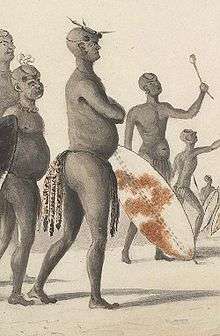Mzilikazi
| Mzilikazi Khumalo | |
|---|---|
| King of Matabeleland | |
 King Mzilikazi, as portrayed by Captain William Cornwallis Harris, circa 1836 | |
| Reign | ca. 1823 – 1868 |
| Coronation | ca. 1820 |
| Predecessor | Founder (father murdered; formerly a lieutenant of Zulu King Shaka) |
| Successor | Lobengula |
| Born |
ca. 1790 Mkuze, South Africa |
| Died |
9 September 1868 Matabeleland, buried in a cave at Entumbane, Matobo Hills, Zimbabwe (on 4 November 1868) |
| Spouse | several wives |
| Issue | Lobengula (son), Nkulumane (son), and many others |
| House | Khumalo; founder of the Ndebele people |
| Father | Matshobana KaMangete (c. late 1700s – c. 1820s), |
| Mother | Nompethu KaZwide, daughter of Chief Zwide of the Ndwandwe people (tribe). |
Mzilikazi, also spelled Mosilikatze or Moselekatze (ca. 1790 – 9 September 1868), was a Southern African king who founded the Matabele kingdom (Mthwakazi), Matabeleland, in what became Rhodesia and is now Zimbabwe. His name means "the great road". He was born the son of Matshobana near Mkuze, Zululand (now part of South Africa), and died at Ingama, Matabeleland (near Bulawayo, Zimbabwe). Many consider him to be the greatest Southern African military leader after the Zulu king Shaka. David Livingstone, in his autobiography, referred to Mzilikazi as the second most impressive leader he encountered on the African continent.
Leaving Zululand
He took his tribe, the Khumalo, on an 800 km journey from the Zulu Kingdom to what is now called Zimbabwe. Along the way, he showed considerable statesmanship, as he was able to weld his own people and the many tribes he conquered into a large and ethnically diverse but centralised kingdom.
He was originally a lieutenant of Shaka but had a quarrel with him in 1823 and rebelled. Rather than face ritual execution, he fled northwards with his tribe. He first travelled to Mozambique but in 1826 he moved west into the Transvaal due to continued attacks by his enemies. As he conquered the Transvaal he absorbed many members of other tribes and established a military despotism, such as Mzilikazi's attacks in the Nzunza kraal at Esikhunjini, where the Nzunza king Magodongo and others were kidnapped and subsequently killed at Mkobola river.
For the next ten years, Mzilikazi dominated the Transvaal. This period, known locally as the Mfecane (crushing) was characterised by devastation and murder on a grand scale as Mzilikazi removed all opposition and remodelled the territory to suit the new Ndebele order. He used the method of scorched earth to keep distance to all surrounding kingdoms. The death toll has never been satisfactorily determined, but the region was so depopulated that the Voortrekkers were able to occupy and take ownership of the Highveld area without opposition in the 1830s.[1]
Meeting the Boers
The Boers began to arrive in Transvaal in 1836, and, after several confrontations over the next two years, the Ndebele suffered heavy losses. By early 1838, Mzilikazi was forced north across the Limpopo and out of Transvaal altogether. Further attacks first caused him to move west again to present-day Botswana and then later northwards towards what is now Zambia. He was unable to settle the land there because of the prevalence of tsetse fly-borne diseases of oxen. Mzilikazi therefore travelled southeastwards to what became known as Matabeleland (situated in the southwest of present-day Zimbabwe) and settled there in 1840.
After his arrival, he organised his followers into a military system with regimental kraals, similar to those of Shaka, which became strong enough to repel the Boer attacks of 1847–1851 and persuade the government of the South African Republic to sign a peace treaty with him in 1852.
Matabele Kingdom
While Mzilikazi was generally friendly to European travellers, he remained mindful of the danger that they posed to his kingdom and, in later years, he refused some visitors any access to his realm. The many European travelers who met with Mzilikazi include Henry Hartley the hunter and explorer, Robert Moffat the missionary, David Hume the explorer and trader, Andrew Smith the medical doctor, ethnologist and zoologist, William Cornwallis Harris the hunter and the missionary explorer David Livingstone.
During the tribe's wanderings north of the Limpopo Mzilikazi became separated from the bulk of the tribe who gave him up for dead and hailed his young heir Nkulumane as successor. However, on his reappearance after a traumatic journey through the Zambezi valley, Mzilikazi asserted control once more. According to one account, he had his son and all those chiefs who had chosen him put to death. They were all executed by being cast over a steep cliff on a hill now called Ntabazinduna (hill of the chiefs).
Another account claims that Nkulumane was not killed with the chiefs, as is popular belief, but was sent back to the Zulu Kingdom with a sizeable delegation including warriors. On his journey south, he passed through the Bakwena territory in the northwestern Transvaal, near Rustenburg. The Bakwena were at the time struggling to repel frequent attacks from a neighbouring king, who wanted to lay claim to the territory that they occupied. Nkulumane assisted the Bakwena by leading his impi in a battle in which the neighbouring chief was killed by Nkulumane himself.
Following this victory, the Bakwena convinced Nkulumane to settle in their territory, arguing that it would be futile to return to the Zulu kingdom as his father's enemies would probably kill him. Nkulumane settled and lived with his family in that area until his death, in 1883. His gravesite, covered in a concrete slab, is on the outskirts of Rustenburg in Phokeng. The gravesite is incongruously referred to as Mzilikazi's kop, even though it is his son who is buried there.
After resuming his role as chief, Mzilikazi made his capital 5 km distant from Ntabazinduna and named it ko-Bulawayo (place of slaughter). Shaka's capital was also called Bulawayo.[2][3]
References
External links
|